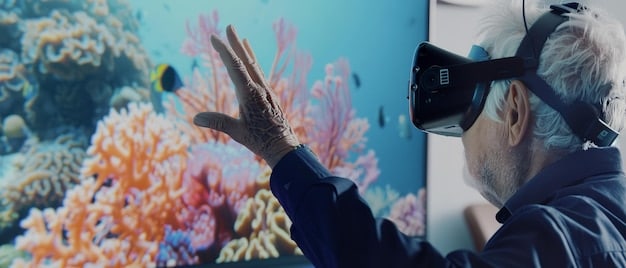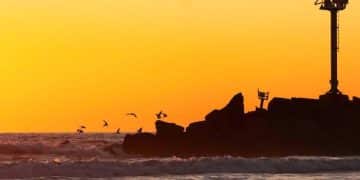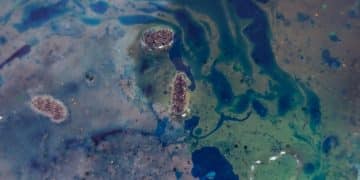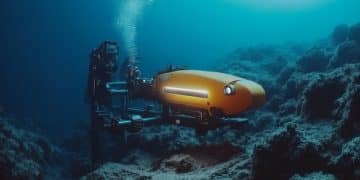Citizen Scientists: Monitoring Marine Biodiversity in US Waters

Citizen scientists play a crucial role in monitoring marine biodiversity across US waters by actively participating in data collection, identification, and reporting initiatives, significantly enhancing conservation efforts and scientific understanding.
The vast and mysterious underwater world of the United States harbors an incredible diversity of marine life, a treasure vital to ecological balance and human well-being. But effectively monitoring this complex biodiversity is a colossal task, one that often exceeds the capacity of professional scientists alone. This is precisely where the power of community engagement shines, as we explore How Can Citizen Scientists Contribute to Monitoring Marine Biodiversity in the US? A Step-by-Step Guide. Imagine everyday individuals, just like you, becoming eyes and ears for our oceans, collecting invaluable data that shapes conservation strategies and deepens our scientific knowledge.
Understanding Citizen Science and Its Impact
Citizen science, at its core, involves public participation in scientific research. In the context of marine biodiversity, this translates into non-professionals contributing to data collection, analysis, and interpretation. This collaborative approach significantly expands the geographic reach and temporal scale of monitoring efforts, providing data that would be otherwise impossible for limited scientific teams to gather.
The impact of citizen science on marine conservation is profound. By engaging a broad network of volunteers, projects can rapidly amass large datasets on species distribution, population trends, habitat health, and the presence of invasive species. This collective effort not only aids scientific understanding but also fosters a deeper connection between individuals and their local marine environments.
The Value of Distributed Effort
One of the primary benefits of citizen science is the distributed nature of its data collection. Instead of relying on a few research vessels or dive teams, citizen scientists spread across various coastal regions, lakes, and even in their homes can report observations. This widespread coverage is especially critical for monitoring elusive species or detecting subtle environmental changes that might go unnoticed by traditional methods.
- Increased Data Volume: More eyes mean more observations, leading to larger and more robust datasets.
- Geographic Breadth: Data can be collected from diverse locations, including remote or less-studied areas.
- Long-Term Monitoring: Volunteer involvement often ensures continuous data collection over extended periods, critical for trend analysis.
- Cost-Effectiveness: Citizen science significantly reduces the operational costs associated with large-scale research projects.
Furthermore, citizen science empowers individuals, turning passive observers into active participants in scientific discovery and environmental stewardship. This engagement can lead to increased environmental literacy and a greater sense of responsibility towards marine ecosystems.
The rise of digital tools and mobile applications has revolutionized citizen science, making participation more accessible and data collection more efficient. These platforms allow for rapid submission of observations, often accompanied by photos or videos, which greatly enhance data quality and verifiability. This blend of community enthusiasm and technological innovation makes citizen science an indispensable tool for marine biodiversity monitoring in the US.
Choosing the Right Project: Aligning Passions with Purpose
With numerous organizations and initiatives focused on marine conservation, selecting the right citizen science project is a crucial first step. It’s essential to align your interests, skills, and available time with a project that truly resonates with you. Whether you’re passionate about marine mammals, coral reefs, or coastal birds, there’s likely a project perfectly suited for your involvement.
When evaluating potential projects, consider their focus areas. Some projects may concentrate on specific species, such as whale identification or sea turtle nesting surveys, while others might focus on broader ecological monitoring, like reef health assessments or plastic pollution tracking. Understanding the project’s objectives will help you determine if it’s a good fit for your contributions.
Key Considerations for Project Selection
Before committing to a project, it’s wise to research its methodology, training requirements, and data utilization. Trustworthy projects will have clear protocols for data collection, often provide comprehensive training, and openly communicate how the collected data contributes to scientific and conservation outcomes.
- Project Scope: Does it align with your interests (e.g., specific species, habitats, or environmental issues)?
- Time Commitment: Are the time requirements reasonable for your schedule (e.g., one-off events, weekly surveys, seasonal commitments)?
- Training and Support: Does the organization offer adequate training and ongoing support for its volunteers?
- Data Usage: How is the collected data used? Is it published, shared with government agencies, or used for policy advocacy?
- Geographic Location: Is the project located in an area accessible to you, or can you participate remotely?
Many projects offer introductory sessions or online resources to help potential volunteers understand their roles and responsibilities. Taking advantage of these resources can provide valuable insight into the project’s day-to-day operations and help you make an informed decision. Remember, the goal is productive and fulfilling participation.
Some prominent organizations facilitating marine citizen science in the US include NOAA, National Marine Sanctuaries, local aquariums, and various non-profit environmental groups. Exploring their websites and outreach programs is an excellent starting point for discovering opportunities to contribute to marine biodiversity monitoring.
Essential Tools and Training for Citizen Scientists
Becoming an effective citizen scientist in marine biodiversity monitoring requires more than just enthusiasm; it necessitates the right tools and proper training. While sophisticated equipment is often provided by the project organizers, understanding basic field techniques and data recording methods is paramount for ensuring data quality and consistency.
The tools required can vary greatly depending on the project. For beach cleanups and coastal debris monitoring, simple items like gloves, trash bags, and data sheets might suffice. However, for underwater surveys, participants might need snorkeling or diving gear, underwater cameras, slate boards for note-taking, and perhaps even GPS devices. Always clarify what equipment will be provided and what you are expected to bring or acquire.
Acquiring Necessary Skills and Knowledge
Most reputable citizen science projects offer comprehensive training programs. These programs are designed to equip volunteers with the specific skills needed for their observational tasks, whether it’s species identification, data recording, or operating specialized equipment. Training often covers:
- Species Identification: Learning to accurately identify marine flora and fauna relevant to the project.
- Survey Protocols: Understanding standardized methods for data collection to ensure consistency and comparability.
- Data Entry: Training on how to correctly record observations, often using specific forms, mobile apps, or online platforms.
- Safety Procedures: Essential for any fieldwork, especially in marine environments, covering everything from weather awareness to emergency protocols.
Many projects utilize online modules, webinars, field sessions, or a combination of these to deliver training. Engaging actively in these training opportunities is crucial for building confidence and ensuring your contributions are valuable. Don’t hesitate to ask questions and seek clarification on any aspect of the protocols.

Beyond formal training, continuous learning can enhance your citizen science experience. Resources such as field guides, identification apps, and online forums can help deepen your knowledge and refine your observational skills. The more proficient you become, the more impactful your contributions will be to the broader scientific understanding of marine biodiversity.
Data Collection Techniques: What to Observe and How to Record It
Accurate and consistent data collection is the cornerstone of any successful citizen science initiative. Without reliable data, even the most passionate efforts yield limited scientific value. The “what” and “how” of data recording are meticulously defined by each project’s protocols, designed to ensure uniformity and usability of the collected information.
Typically, marine biodiversity projects will instruct citizen scientists on specific parameters to observe. This could include counting individual animals, estimating population sizes, noting behaviors (e.g., feeding, mating), recording environmental conditions (e.g., water temperature, clarity), or documenting the presence of marine debris. The details matter, as even seemingly minor observations can reveal significant patterns over time.
Standardized Reporting for Scientific Rigor
To maintain scientific rigor, most projects employ standardized data sheets, mobile applications, or online submission portals. These tools often feature drop-down menus, checklist options, and specific fields for numerical entries, minimizing errors and ensuring all necessary information is captured. Key elements of effective data recording often include:
- Date and Time: Essential for tracking changes and correlating observations with environmental events.
- Location (GPS Coordinates): Crucial for mapping species distribution and habitat use.
- Observer Name/ID: Allows for tracking contributions and contacting observers for clarification.
- Species Observed: Accurate identification is paramount; often includes quantity and specific notes.
- Environmental Conditions: Such as weather, water temperature, visibility, and tidal state.
- Photos/Videos: Visual evidence greatly enhances data quality and verifiability.
Detailed notes regarding any unusual observations, such as injured animals, pollution incidents, or interactions between species, are also highly valuable. The more comprehensive and precise your recording, the more useful the data will be for scientists and conservation managers.
Adherence to the project’s specific protocols is non-negotiable. Deviation from these guidelines can compromise the integrity of the data, making it less reliable for scientific analysis. If unsure about any aspect of data collection or recording, always refer to your training materials or contact project coordinators for guidance.
Contributing Data: Platforms and Protocols
Once data is collected, the next critical step for citizen scientists is its accurate and timely submission to the designated platforms. These platforms are designed to aggregate, store, and often visualize the vast amounts of information contributed by volunteers, making it accessible for scientific analysis and conservation planning.
The majority of marine citizen science projects today utilize online portals or dedicated mobile applications for data submission. These digital tools streamline the process, often allowing for direct upload of photos, GPS coordinates, and observation details, sometimes even offline synchronization for remote areas. Examples include platforms like iNaturalist, eBird (for coastal birds), REEF Environmental Education Foundation (REEF) for fish surveys, and various project-specific applications.
Ensuring Data Quality and Verification
Maintaining data quality is a top priority for all reputable citizen science programs. While volunteers are trained to collect accurate information, verification processes are often in place to ensure the reliability of the submitted data. This can involve:
- Expert Review: Subject matter experts or experienced volunteers reviewing submitted observations, especially species identifications, based on provided photos or descriptions.
- Peer Review: In some platforms, other citizen scientists can review and confirm submissions, fostering a community of verification.
- Automated Checks: Software can flag improbable data entries, such as species observed far outside their known range or in incorrect habitats.
- Feedback Loops: Providing feedback to volunteers on their submissions, helping them improve accuracy over time.
It’s important for citizen scientists to be responsive to any requests for clarification or additional information regarding their submissions. This collaborative approach to data quality ensures that the aggregated information is scientifically robust and reliable for research and conservation decisions.
Regular and consistent data submission, even for seemingly minor observations, contributes significantly to building comprehensive long-term datasets. These datasets are invaluable for identifying trends, tracking population changes, and assessing the effectiveness of conservation interventions in US marine waters.
Analyzing and Utilizing Citizen Science Data
The journey of citizen science data doesn’t end with its submission; it flows into crucial analysis and utilization phases. This is where raw observations are transformed into actionable insights, influencing scientific papers, policy decisions, and focused conservation efforts. Understanding how your contributions are used can provide a powerful sense of purpose and impact.
Scientists and conservation managers regularly access and analyze citizen science datasets to address specific research questions. For example, data on invasive species sightings can trigger rapid response actions, while long-term records of marine mammal distributions might inform shipping lane adjustments or protected area designations. The sheer volume and geographic spread of citizen-collected data often enable analyses that would be impossible with traditional, smaller-scale research.
Impact on Conservation and Policy
The insights derived from citizen science data have a tangible impact on marine conservation and environmental policy in the US. This impact manifests in several ways:
- Informing Resource Management: Data helps managers make informed decisions about fisheries, habitat restoration, and coastal development.
- Policy Development: Evidence from citizen science can support the creation of new regulations or strengthen enforcement of existing ones, particularly regarding pollution or protected species.
- Early Warning Systems: Rapid reporting of unusual events (e.g., harmful algal blooms, mass strandings) allows for quicker responses.
- Public Awareness and Advocacy: Citizen science findings can be powerful tools for raising public awareness and advocating for stronger environmental protections.

Many organizations also publish “state of the ocean” reports or annual summaries that highlight findings derived from citizen science contributions. These reports are often accessible to the public, providing a transparent look at the collective impact of volunteer efforts and celebrating the dedication of citizen scientists.
Ultimately, the utilization of citizen science data underscores the profound value of community involvement in scientific research. Each observation, each data point, contributes to a larger picture, helping us better understand, protect, and restore the incredible marine biodiversity that graces the waters of the United States.
Challenges and Future Directions for Citizen Scientists
While citizen science has undeniably transformed marine biodiversity monitoring, it is not without its challenges. Addressing these issues is crucial for maximizing its potential and ensuring long-term sustainability. Understanding these hurdles helps both project organizers and citizen scientists work towards more effective and impactful collaborations.
One of the primary challenges revolves around data quality and consistency. Despite thorough training, variability in observational skills among volunteers can lead to errors or inconsistencies. Ensuring rigorous verification processes and providing continuous feedback mechanisms are essential for mitigating this. Another challenge is volunteer retention; maintaining engagement over long periods requires innovative strategies and clear communication of impact.
Overcoming Obstacles and Embracing Innovation
To overcome these challenges, citizen science initiatives are continually evolving. Technological advancements are playing a significant role in improving data collection accuracy and volunteer engagement:
- AI and Machine Learning: Tools for automated species identification (e.g., using image recognition) can assist volunteers and streamline verification.
- Gamification: Incorporating game-like elements (e.g., badges, leaderboards) to motivate volunteers and encourage sustained participation.
- Enhanced Training: Developing immersive online training modules and virtual reality simulations to improve skill acquisition.
- Community Building: Fostering stronger online and offline communities among volunteers to enhance peer support and knowledge sharing.
Looking ahead, citizen science is poised to become even more integral to marine conservation. Its ability to scale research efforts, democratize scientific discovery, and foster environmental stewardship makes it an indispensable tool for addressing the escalating threats to marine biodiversity. The increasing accessibility of technology and growing public awareness of environmental issues suggest a bright future for citizen scientists.
The collective power of individuals, armed with curiosity and dedicated to contributing, truly represents the next frontier in understanding and safeguarding our invaluable marine ecosystems. Your involvement, however small, weaves into a larger tapestry of knowledge and action that ultimately protects the marine life of the US.
| Key Contribution | Brief Description |
|---|---|
| 🐠 Data Collection & Reporting | Actively participate in gathering real-time observations of marine species and habitats. |
| 👨🏫 Skill Development | Undergo training to accurately identify species and follow standardized survey protocols. |
| 📈 Trend Monitoring | Contribute to long-term datasets valuable for tracking biodiversity changes and health. |
| 🌍 Local Advocacy | Increase local awareness and support for marine conservation through direct involvement. |
Frequently Asked Questions About Citizen Science in Marine Biodiversity
Citizen science in marine biodiversity involves non-professional individuals actively participating in scientific research focused on marine life. This includes data collection, observations, and reporting on species, habitats, and environmental conditions, thereby contributing to conservation and scientific understanding.
No, a scientific background is generally not required. Most reputable citizen science projects provide comprehensive training and resources to equip volunteers with the necessary skills for data collection and species identification. Enthusiasm and a willingness to learn are often the key requirements.
Your collected data helps scientists understand population trends, species distribution, invasive species presence, and habitat health. This information informs conservation strategies, policy decisions, and resource management efforts, directly contributing to the protection and restoration of marine ecosystems.
A wide range of marine life can be monitored. Projects exist for fish, marine mammals (whales, dolphins, seals), sea turtles, corals, coastal birds, invertebrates, and even marine debris or water quality. You can choose a project that aligns with your specific interests.
Yes, many projects utilize dedicated mobile apps or online portals for data submission, often allowing for direct upload of photos, GPS coordinates, and detailed observations. Popular platforms include iNaturalist, REEF, and specific apps developed by project organizations, ensuring ease of use and data accuracy.
Conclusion
The role of citizen scientists in monitoring and safeguarding marine biodiversity in the US has evolved from a niche activity into an indispensable component of modern conservation efforts. By offering their time, curiosity, and local expertise, these dedicated individuals vastly extend the reach of scientific inquiry, providing crucial data that informs research, influences policy, and inspires broader community engagement. As we face growing environmental challenges, the collective power of citizen scientists will remain a beacon of hope, ensuring a more vibrant and resilient future for America’s invaluable marine ecosystems.





